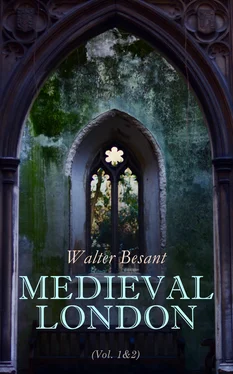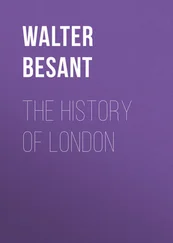Among the ships of Edward’s Fleet were three belonging to London: “La Jonette,” “La Cogge,” and “La Sainte Marie Cogne.” The last ship belonged to William Haunsard, ex-Sheriff. London also sent a contingent of nearly 200 men fully armed on board these ships. These ships were among those which fought in the great victory of Sluys. The battle is thus described by the French Chronicle:—
“In this year all the mariners of England, by commission of our Lord the King, had all their ships speedily assembled and victualled, and hardy and vigorous men from all parts well equipped and armed at all points, in every place to fight for life or death. And when the fleet of ships of England was assembled in manner aforesaid, Sir Edward, our King, and his people were in the parts of Bury Saint Edmund’s: and from thence he passed on to Orwelle, where he put to sea, with his people beyond number, upon the Thirsday next before the Nativity of Saint John the Baptist (24 June) which was on a Saturday: and upon the next Friday morning, our King espied his enemies upon the sea, and said ‘Because our Lord Jesus Christ was put to death on a Friday, we will not shed blood upon that day.’
The wind had then been in the east for a whole fortnight before the King put to sea, but by the grace of Him who is Almighty, the wind shifted immediately to the west: so that by the grace of God, the King and his fleet had both wind and weather to their mind. And so they sailed on until sunrise at break of day: when he saw his enemies so strongly equipped, that it was a most dreadful thing to behold: for the fleet of the ships of France was so strongly bound together with massive chains, castles, bretasches, and bars. But, notwithstanding this, Sir Edward our King, said to all those who were around him in the fleet of England:—‘Fair lords and brethren of mine, be nothing dismayed, but be all of good cheer, and he who for me shall begin the fight and shall combat with a right good heart, shall have the benison of God Almighty: and everyone shall retain that which he shall gain.’
And so soon as our King had said this, all were of right eager heart to avenge him of his enemies. And then our mariners hauled their sails half-mast high, and hauled up their anchors in manner as though they intended to fly: and when the fleet of France beheld this, they loosened themselves from their heavy chains to pursue us. And forthwith our ships turned back upon them, and the mêlée began, to the sound of trumpets, nakers, viols, tabors, and many other kinds of minstrelsy. And then did our King, with three hundred ships, vigorously assail the French with their five hundred great ships and gallies, and eagerly did our people exert great diligence to give battle to the French. Our archers and our arbalesters began to fire as densely as hail falls in winter, and our engineers hurled so steadily, that the French had not power to look or to hold up their heads. And in the meantime, while this assault lasted, our English people with a great force boarded their gallies, and fought with the French hand to hand, and threw them out of their ships and gallies. And always our King encouraged to fight bravely with his enemies, he himself being in the cog called ‘Thomas of Winchelsee.’ And at the hour of tierce there came to them a ship of London, which belonged to William Haunsard, and it did much good in the said battle. For the battle was so severe and so hardly contested, that the assault lasted from noon all day and all night, and the morrow until the hour of prime: and when the battle was discontinued no French man remained alive, save only Spaudefisshe, who took to flight with four and twenty ships and gallies.”
The Battle of Sluys was followed by the Siege of Tournay which proved fruitless: the King came home without any money, and furious against his ministers, whom he sent to prison. An inquiry was ordered as to the mode of collecting the King’s revenues in the City. The citizens objected to the judges holding this session in the City; they refused to answer any questions unless their liberties were respected; they raised a special fund for the purpose of defending the City’s rights. The King retorted by ordering an Iter, but being unwilling to alienate the City, which was so useful in time of war, he desisted and gave the citizens a new Charter (26th March 1341). At the same time they were called upon to provide twenty-six ships fully equipped and victualled, and the King for his part got another thousand pounds for himself. After a truce for three years the war was renewed. In March 1346 the London contingent of 600 archers, 100 men-at-arms, and 200 horsemen, were called out and paraded on Tothill Fields. They sailed with the King’s fleet of a thousand ships on the 10th July 1346.
After the battle of Crecy the King sent word to the Mayor that many of his men had deserted, and that all who could be found were to be seized and sent back, whether they were knights, esquires, or of lower order. This seems to show that they went out on short service time which had expired. It also shows that no police existed to prevent deserters from taking ship across the Channel. Another fleet was fitted out to which the City contributed two ships. All the ships in the port were also seized.
After the surrender of Calais the King came home, his army laden with spoil. “And now,” says Holinshed, “it seemed to the English people that the sunne breake foorth after a long cloudie season, by reason both of the great plentie of althings, and remembrance of the late glorious victories: for there were few women that were housekeepers within this land, but they had some furniture of household that had beene brought to them out of France as part of the Spoile got in Caen, Calis, Carenten, or some other good towne. And beside household stuffe, the English maides and matrones were bedecked and trimmed up in French women’s jewels and apparell, so that as the French women lamented for the loss of these things, so our women rejoiced of the gaine.”
In the twentieth year of Edward’s reign he issued an ordinance providing for the expulsion of all leprous persons from the City. “Forasmuch,” he begins, “as we have been given to understand that many persons, as well of the City aforesaid, as others coming to the same City, being smitten with the blemish of leprosy, do publicly dwell among the other citizens and sound persons and there continually abide; and do not hesitate to communicate with them as well in public places as in private: and that some of them endeavouring to contaminate others with that abominable blemish (that so to their own wretched solace they may have the more fellows in suffering) as well as in the way of mutual communication, and by the contagion of their polluted breath, and by sexual intercourse with women in stews and other secret places detestably frequenting the same, do so taint persons who are sound, both male and female, to the great injury of the people dwelling in the City aforesaid, and the manifest peril of other persons to the same City resorting....” And he orders the removal of all such persons from the City within fifteen days, and forbids for the future any one to harbour in his house any one “smitten with the blemish of leprosy.” This order seems to have been obeyed.
It is unfortunate that we do not know the number of the wretched lepers who were thus driven out. The disease itself, the ravages of which had been terrible, was now slowly disappearing: within two hundred years from this time it had practically disappeared. That there were still a good number of lepers in London is proved by the fact that the citizens in obedience to the law began to build lazar houses outside the City. Three at least there were already: that of St. Giles in the Fields, founded by Queen Matilda, wife of Henry I.; that of St. James in the Fields, founded for leprous virgins; and that of Great Ilford in Essex, founded by King Stephen, the only one now left of the leprous foundations. The new lazar houses erected were: one at the Lock without Southwark in Kent Street; one between Mile End Road and Stratford-le-Bow; one at Kingsland between Shoreditch and Stoke Newington; and one at Knightsbridge. One is mentioned twenty years later at Hackney. Another was founded a hundred years later by one William Yeoman of the Crown, himself a leper, on the high road between Highgate and Holloway. Twenty-six years later John Mayn, a baker and a leper, “who had oftentimes been before commanded by the Mayor and Aldermen to depart from the City” (oftentimes! Here is a proof of the weakness of the Executive!), was finally ordered to depart at once. It is not stated whether he obeyed.
Читать дальше












